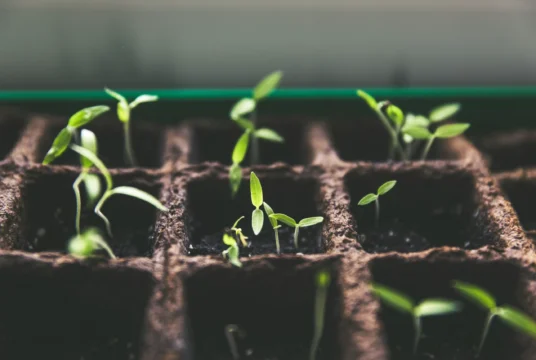Organic gardening is an eco-friendly approach to growing plants, vegetables, and flowers that focuses on using natural methods to nourish the soil, control pests, and promote healthy plant growth. It’s not just about avoiding harmful chemicals; it’s about fostering a balanced ecosystem where nature’s processes work harmoniously. Whether you’re a seasoned gardener or just starting, embracing organic gardening techniques can help you grow food that is healthy for both you and the environment. Here’s how to grow without chemicals and make your garden thrive naturally.
1. Start with Healthy Soil
Soil is the foundation of any garden, and healthy soil is essential for organic gardening. In conventional gardening, synthetic fertilizers are often used to provide quick fixes, but they can harm the soil’s natural balance over time. In organic gardening, the goal is to improve soil health through natural means, which will ultimately support healthy plant growth.
- Compost: Compost is a vital part of organic gardening. It enriches the soil with organic matter, improves its texture, and provides essential nutrients. You can make your own compost by collecting kitchen scraps like fruit peels, vegetable trimmings, coffee grounds, and yard waste like grass clippings and leaves. Over time, this organic material breaks down, creating a nutrient-rich blend that can be used as a natural fertilizer.
- Organic Mulch: Organic mulches such as straw, wood chips, or leaves help retain soil moisture, regulate temperature, and prevent weeds from growing. As it decomposes, mulch also adds valuable organic matter to the soil.
2. Use Natural Pest Control
One of the main challenges of organic gardening is dealing with pests without using chemical pesticides. While this can seem daunting at first, there are several natural pest control methods that can keep your garden healthy and thriving.
- Beneficial Insects: Insects like ladybugs, lacewings, and predatory beetles are nature’s pest controllers. These beneficial insects feed on harmful pests such as aphids, mites, and caterpillars. You can attract them by planting flowers like dill, fennel, and yarrow, which provide nectar and habitat.
- Neem Oil: Neem oil is a natural pesticide made from the seeds of the neem tree. It works by disrupting the life cycle of insects, making it an effective pest control method for many types of bugs without harming your plants or the environment.
- Companion Planting: Certain plants can be used to repel pests or attract beneficial insects. For example, planting marigolds alongside vegetables like tomatoes can help keep aphids at bay. Similarly, basil and garlic are often planted near tomatoes to deter pests like whiteflies and mosquitoes.
3. Practice Crop Rotation
Crop rotation is a technique where you change the type of plants grown in a specific area of the garden each year. This practice helps prevent soil depletion and reduces the risk of pest and disease buildup. Certain pests and diseases thrive on specific plant species, so by rotating crops, you can break the cycle and reduce the need for chemical treatments.
For example, if you grow tomatoes in one area of your garden one year, plant beans or peas the following year to ensure the soil remains healthy and free from tomato-specific diseases. This practice also helps improve soil fertility by varying the nutrients used by each crop.
4. Water Wisely
Watering plays an important role in organic gardening. Overwatering can lead to root rot and provide the perfect breeding ground for diseases, while underwatering stresses the plants and makes them more susceptible to pests. In organic gardening, it’s crucial to focus on watering practices that support plant health.
- Drip Irrigation: Drip irrigation is an efficient way to water your garden. It delivers water directly to the roots of the plants, reducing water waste and preventing water from splashing onto the leaves, which can lead to disease.
- Watering Early in the Morning: Watering in the early morning allows the water to soak into the soil before the heat of the day. It also helps prevent the growth of fungal diseases that thrive in damp conditions.
5. Encourage Biodiversity
A healthy organic garden thrives on biodiversity, where different species of plants, insects, and microorganisms coexist and support one another. This diversity helps create a balanced ecosystem where pests are kept in check, pollination is encouraged, and soil health is maintained.
- Plant a Variety of Crops: By growing a wide range of plants, you not only increase your chances of success but also create an environment where pests are less likely to become a problem. Some plants can act as natural pest repellents, while others can attract pollinators like bees and butterflies.
- Create Habitats for Wildlife: Building birdhouses, bee hotels, or adding a small pond can encourage wildlife in your garden. Birds and other animals can act as natural pest controllers, while pollinators help your plants thrive.
Conclusion
Organic gardening offers a more sustainable way of growing plants, vegetables, and flowers without the use of harmful chemicals. By focusing on healthy soil, natural pest control, crop rotation, wise watering practices, and encouraging biodiversity, you can create a thriving garden that’s not only beneficial for you but also for the planet. Though it may take a little more time and effort compared to traditional gardening, the rewards of organic gardening are immense—healthier food, a more eco-friendly approach, and a deeper connection to nature. By taking these steps, you’ll be well on your way to cultivating a garden that is as beautiful as it is sustainable.

